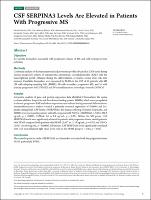| dc.contributor | Vall d'Hebron Barcelona Hospital Campus |
| dc.contributor.author | Matute Blanch, Clara |
| dc.contributor.author | Osman, Mohamoud |
| dc.contributor.author | Costa Riu, Carme |
| dc.contributor.author | Pinteac, Rucsanda |
| dc.contributor.author | Miró Cau, Berta |
| dc.contributor.author | Sánchez Pla, Alex |
| dc.contributor.author | Brito, Veronica Ines |
| dc.contributor.author | Montalban Gairín, Xavier |
| dc.contributor.author | Comabella Lopez, Manuel |
| dc.contributor.author | Fissolo, Nicolás Miguel |
| dc.date.accessioned | 2022-06-16T08:02:45Z |
| dc.date.available | 2022-06-16T08:02:45Z |
| dc.date.issued | 2021-03 |
| dc.identifier.citation | Fissolo N, Matute-Blanch C, Osman M, Costa C, Pinteac R, Miró B, et al. CSF SERPINA3 Levels Are Elevated in Patients With Progressive MS. Neurol Neuroimmunol Neuroinflamm. 2021 Mar;8(2):e941. |
| dc.identifier.issn | 2332-7812 |
| dc.identifier.uri | https://hdl.handle.net/11351/7703 |
| dc.description | Multiple sclerosis; SERPINA3 |
| dc.description.abstract | Objective To identify biomarkers associated with progressive phases of MS and with neuroprotective potential.
Methods Combined analysis of the transcriptional and proteomic profiles obtained in CNS tissue during chronic progressive phases of experimental autoimmune encephalomyelitis (EAE) with the transcriptional profile obtained during the differentiation of murine neural stem cells into neurons. Candidate biomarkers were measured by ELISA in the CSF of 65 patients with MS (29 with relapsing-remitting MS [RRMS], 20 with secondary progressive MS, and 16 with primary progressive MS [PPMS]) and 30 noninflammatory neurologic controls (NINCs).
Results Integrative analysis of gene and protein expression data identified 2 biomarkers, the serine protease inhibitor Serpina3n and the calcium-binding protein S100A4, which were upregulated in chronic progressive EAE and whose expression was induced during neuronal differentiation. Immunofluorescence studies revealed a primarily neuronal expression of S100A4 and Serpina3n during EAE. CSF levels of SERPINA3, the human ortholog of murine Serpina3n, and S100A4 were increased in patients with MS compared with NINCs (SERPINA3: 1,320 vs 838.6 ng/mL, p = 0.0001; S100A4: 1.6 vs 0.8 ng/mL, p = 0.02). Within the MS group, CSF SERPINA3 levels were significantly elevated in patients with progressive forms, mainly patients with PPMS compared with patients with RRMS (1,617 vs 1,129 ng/mL, p = 0.02) and NINCs (1,617 vs 838.6 ng/mL, p = 0.0001). Of interest, CSF SERPINA3 levels significantly correlated with CSF neurofilament light chain levels only in the PPMS group (r = 0.62, p = 0.01).
Conclusion These results point to a role of SERPINA3 as a biomarker associated with the progressive forms of MS, particularly PPMS. |
| dc.language.iso | eng |
| dc.publisher | Wolters Kluwer Health |
| dc.relation.ispartofseries | Neurology neuroimmunology & neuroinflammation.;8(2) |
| dc.rights | Attribution-NonCommercial-NoDerivatives 4.0 International |
| dc.rights.uri | http://creativecommons.org/licenses/by-nc-nd/4.0/ |
| dc.source | Scientia |
| dc.subject | Marcadors bioquímics |
| dc.subject | Esclerosi múltiple - Diagnòstic |
| dc.subject | Enzims proteolítics - Inhibidors |
| dc.subject.mesh | Multiple Sclerosis, Chronic Progressive |
| dc.subject.mesh | Serpins |
| dc.subject.mesh | Biomarkers |
| dc.title | CSF SERPINA3 Levels Are Elevated in Patients With Progressive MS |
| dc.type | info:eu-repo/semantics/article |
| dc.identifier.doi | 10.1212/NXI.0000000000000941 |
| dc.subject.decs | esclerosis múltiple crónica progresiva |
| dc.subject.decs | serpinas |
| dc.subject.decs | biomarcadores |
| dc.relation.publishversion | https://doi.org/10.1212/NXI.0000000000000941 |
| dc.type.version | info:eu-repo/semantics/publishedVersion |
| dc.audience | Professionals |
| dc.contributor.organismes | Institut Català de la Salut |
| dc.contributor.authoraffiliation | [Fissolo N, Matute-Blanch C, Costa C, Pinteac R, Brito V, Comabella Lopez M] Servei de Neurologia-Neuroimmunologia, Centre d’Esclerosi Múltiple de Catalunya (CEMCAT), Barcelona, Spain. Vall d’Hebron Institut de Recerca (VHIR), Barcelona, Spain. Vall d’Hebron Hospital Universitari, Barcelona, Spain. Universitat Autònoma de Barcelona, Bellaterra, Spain. [Osman M] Biotech Research and Innovation Centre (BRIC), University of Copenhagen, Denmark. [Miró B] Unitat d'Estadística i Bioinformàtica, Vall d’Hebron Institut de Recerca (VHIR), Barcelona, Spain. [Sanchez A] Unitat d'Estadística i Bioinformàtica, Vall d’Hebron Institut de Recerca (VHIR), Barcelona, Spain. Genetics, Microbiology and Statistics Department, Universitat de Barcelona, Spain. [Montalban X] Servei de Neurologia-Neuroimmunologia, Centre d’Esclerosi Múltiple de Catalunya (CEMCAT), Barcelona, Spain. Vall d’Hebron Institut de Recerca (VHIR), Barcelona, Spain. Vall d’Hebron Hospital Universitari, Barcelona, Spain. Universitat Autònoma de Barcelona, Bellaterra, Spain. Center for Multiple Sclerosis, St. Michael’s Hospital, University of Toronto, ON, Canada |
| dc.identifier.pmid | 33436375 |
| dc.identifier.wos | 000656639200009 |
| dc.relation.projectid | info:eu-repo/grantAgreement/ES/PE2013-2016/RD16%2F0015%2F0004 |
| dc.rights.accessrights | info:eu-repo/semantics/openAccess |

